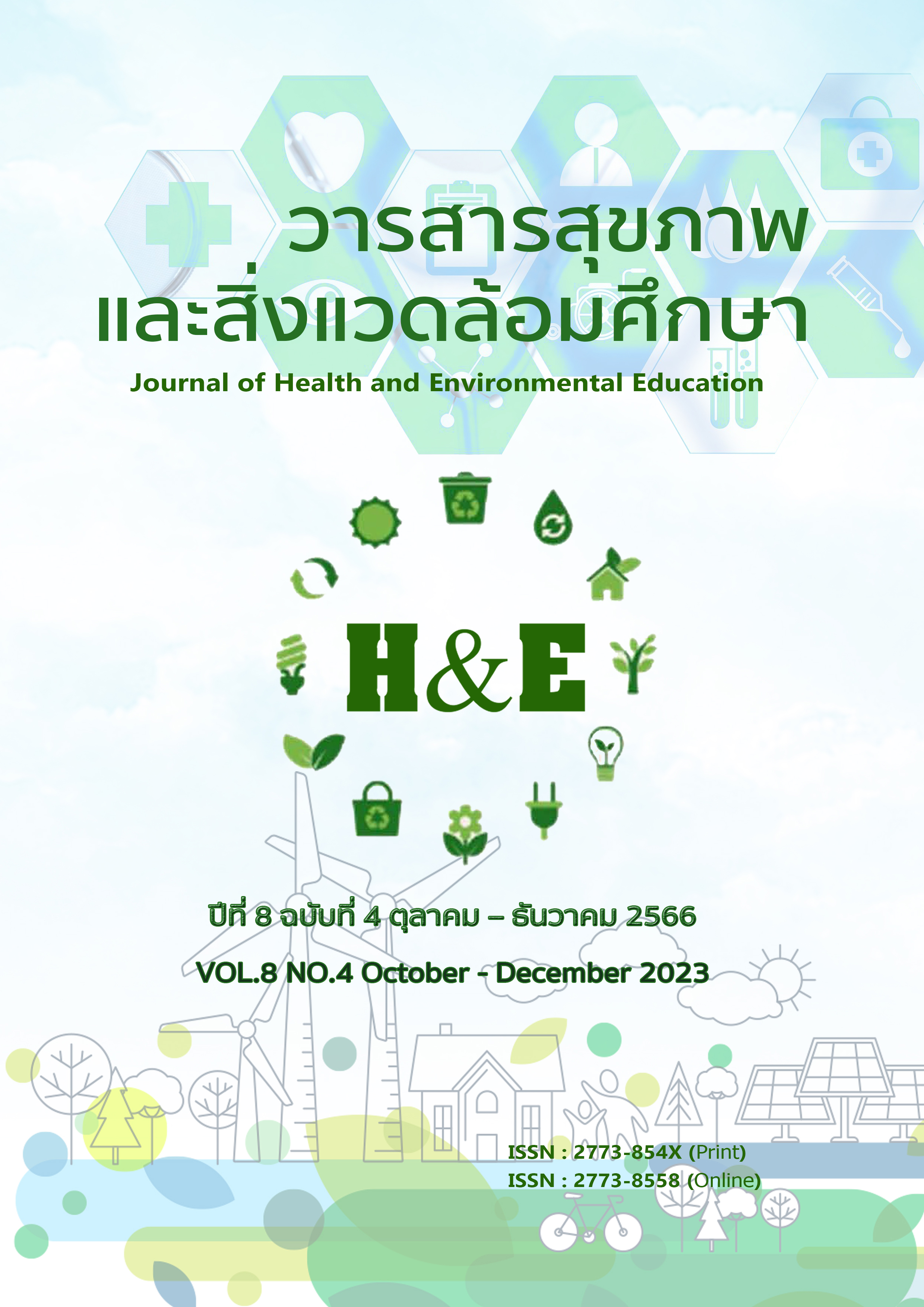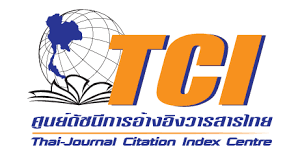Rate of Contamination from Blood Culture in Suratthani Hospital Suratthani Province
Keywords:
hemoculture, contamination, bacteremia, sepsisAbstract
This research was survey research by cross sectional study. The objective was to study the contamination rate and type of contaminants in the hemoculture of patients admitted to the emergency department in Suratthani hospital, Suratthani province during January - December 2022. Patient data and laboratory hemoculture results were analyzed by calculating the percentage of contaminants from blood samples of 3,182 patients. The results showed 237 (7.45%) positive hemoculture samples for contaminants. The most hemoculture contaminants was the coagulase-negative Staphylococci (16.00%). The most cases of hemoculture contaminants were elderly patients aged 61 years and over (8.79%) and the least contaminated were among patients aged 21-40 years (4.35%). The hemoculture contaminants from each groups were predominantely gram positive bacteria found as the human skin flora.
References
Lever A, Mackenzie I. Sepsis: definition, epidemiology, and diagnosis. BMJ. 2007;335(7625):879-83.
Martín S, Pérez A, Aldecoa C. Sepsis and Immunosenescence in the Elderly Patient: A Review. Front Med (Lausanne). 2017;4:20.
Angus DC, Linde-Zwirble WT, Lidicker J, Clermont G, Carcillo J, Pinsky MR. Epidemiology of severe sepsis in the United States: analysis of incidence, outcome, and associated costs of care. Crit Care Med. 2001;29(7):1303-10.
Uslan DZ, Crane SJ, Steckelberg JM, Cockerill FR 3rd, Sauver JLS, Wilson WR, et al. Age- and sex-associated trends in bloodstream infection: a population-based study in Olmsted County, Minnesota. Arch Intern Med. 2007;167(8):834-9.
Laupland KB, Kibsey PC, Gregson DB, Galbraith JC. Population-based laboratory assessment of the burden of community-onset bloodstream infection in Victoria, Canada. Epidemiol Infect. 2013;141(1):174-80.
Nasa P, Juneja D, Singh O, Dang R, Arora V. Severe sepsis and its impact on outcome in elderly and very elderly patients admitted in intensive care unit. J Intensive Care Med. 2012;27(3):179-83.
Weinstein MP. Blood culture contamination: persisting problems and partial progress. J Clin Microbiol. 2003;41(6):2275-8.
Diekema DJ, Beekmann SE, Chapin KC, Morel KA, Munson E, Doern GV. Epidemiology and outcome of nosocomial and community-onset bloodstream infection. J Clin Microbiol. 2003;41(8):3655-60.
Dumpa V, Adler B, Allen D, Bowman D, Gram A, Ford P, et al. Reduction in Central Line-Associated Bloodstream Infection Rates After Implementations of Infection Control Measures at a Level 3 Neonatal Intensive Care Unit. Am J Med Qual. 2016;34(5):488-93.
Weinstein MP, Towns ML, Quartey SM, Mirrett S, Reimer LG, Parmigiani G, et al. The clinical significance of positive blood cultures in the 1990s: a prospective comprehensive evaluation of the microbiology, epidemiology, and outcome of bacteremia and fungemia in adults. Clin Infect Dis. 1997;24(4):584-602.
Tenderenda A, Lysakowska M, Dargiewicz R, Gawron-Skarbek A. Blood Culture Contamination: A Single General Hospital Experience of 2-Year Retrospective Study. Int J Environ Res Public Health. 2022;19(5):3009.
Nachate S, Rouhi S, Ouassif H, Bennani H, Hachimi A, Mouaffak Y, et al. Multidrug-Resistant Bacteria Isolated from Blood Culture Samples in a Moroccan Tertiary Hospital: True Bacteremia or Contamination? Infect Drug Resist. 2022;15:5691-704.
Chukwuemeka IK, Samuel Y. Quality assurance in blood culture: A retrospective study of blood culture contamination rate in a tertiary hospital in Nigeria. Niger Med J. 2014;55(3):201-3.
Waltzman ML, Harper M. Financial and clinical impact of false-positive blood culture results. Clin Infect Dis. 2001;33(3):296-9.
Mimoz O. Preoperative skin cleansing with chlorhexidine-alcohol reduces surgical site infection after clean-contaminated surgery compared with povidone-iodine. Evid Based Nurs. 2010;13(2):36-7.
Maiwald M, Chan ES. The forgotten role of alcohol: a systematic review and meta-analysis of the clinical efficacy and perceived role of chlorhexidine in skin antisepsis. PLoS One. 2012;7(9):e44277.
Self WH, Speroff T, Grijalva CG, McNaughton CD, Ashburn J, Liu D, et al. Reducing blood culture contamination in the emergency department: an interrupted time series quality improvement study. Acad Emerg Med. 2013;20(1):89-97.
Chang CJ, Wu CJ, Hsu HC, Wu CH, Shih FY, Wang SW, et al. Factors Associated with Blood Culture Contamination in the Emergency Department: Critical Illness, End-Stage Renal Disease, and Old Age. PLoS One. 2015;10(10):e0137653.
Robertson P, Russell A, Inverarity DJ. The effect of a quality improvement programme reducing blood culture contamination on the detection of bloodstream infection in an emergency department. J Infect Prev. 2015;16(2):82-7.
Gander RM, Byrd L, DeCrescenzo M, Hirany S, Bowen M, Baughman J. Impact of blood cultures drawn by phlebotomy on contamination rates and health care costs in a hospital emergency department. J Clin Microbiol. 2009;47(4):1021-4.
Bates DW, Goldman L, Lee TH. Contaminant blood cultures and resource utilization. The true consequences of false-positive results. JAMA. 1991;265(3):365-9.
Kim NH, Kim M, Lee S, Yun NR, Kim KH, Park SW, et al. Effect of routine sterile gloving on contamination rates in blood culture: a cluster randomized trial. Ann Intern Med. 2011;154(3):145-51.
Wilson ML, Thomus JK, Antonara S, Brocious J, Carroll KC, Chamberland R, et al. CLSI document M47 Principles and procedures for blood cultures. 2nd ed. Pennsylvania: Clinical and Laboratory Standards Institute; 2007.
Hall KK, Lyman JA. Updated review of blood culture contamination. Clin Microbiol Rev. 2006;19(4):788-802.
Baron EJ, Weinstein MP, Dunne WM, Yagupsky P, Welch DF, Wilson DM. Cumitech 1C, blood cultures IV. Cumitech C. 2005;1:1-34.
โรงพยาบาลสุราษฎร์ธานี. ยุทธศาสตร์ของประเทศโดยรวม นโยบายและยุทธศาสตร์โรงพยาบาลสุราษฎร์ธานี. [อินเทอร์เน็ต]. 2565 [เข้าถึงเมื่อ 12 ธ.ค.2566]. เข้าถึงได้จาก: https://srth.go.th/news/MyResize/Files_7-8.%20ยุทธศาสตร์ของประเทศโดยรวม%20นโยบายและยุท.pdf
Singer M, Deutschman CS, Seymour CW, Shankar-Hari M, Annane D, Bauer M, et al. The Third International Consensus Definitions for Sepsis and Septic Shock (Sepsis-3). JAMA. 2016;315(8):801-10.
สุวรรณา ตระกูลสมบูรณ์, วิภา ตรีรัตน์วีรพงษ์, ฉันทนา อรัญญะ. การเพาะเชื้อจากเลือด. ใน: มาลัย วรจิตร, วันทนา ปวีณกิตติพร, สุวรรณา ตระกูลสมบูรณ์, สุรางค์ เดชศิริเลิศ, บรรณาธิการ. คู่มือปฏิบัติงานแบคทีเรียและราสำหรับโรงพยาบาลศูนย์และโรงพยาบาลทั่วไป 2561. นนทบุรี : กรมวิทยาศาสตร์การแพทย์ กระทรวงสาธารณสุข; 2561: 54-60.
Gautam V, Sethuraman N, Kaur R, Sachdev S, Marwaha N, Ray P. Changing epidemiology of coagulase-negative staphylococci in normal flora of skin. Indian J Med Microbiol. 2017;35(2):277-78.
Wojtyczka RD, Orlewska K, Kepa M, Idzik D, Dziedzic A, Mularz T, et al. Biofilm formation and antimicrobial susceptibility of Staphylococcus epidermidis strains from a hospital environment. Int J Environ Res Public Health. 2014;11(5):4619-33.
Taha M, Kalab M, Yi QL, Landry C, Greco-Stewart V, Brassinga AK, et al. Biofilm-forming skin microflora bacteria are resistant to the bactericidal action of disinfectants used during blood donation. Transfusion. 2014;54(11):2974-82.
Zimmerman FS, Assous MV, Zevin S, Wiener-Well Y. Reducing blood culture contamination using an initial specimen diversion device. Am J Infect Control. 2019;47(7):822-26.
เยาวมาลย์ เหลืองอร่าม, วิลาวัณย์ พิเชียรเสถียร และลดาวัลย์ ภูมิวิชชุเวช. การลดอัตราการปนเปื้อนเชื้อจุลชีพในตัวอย่างเลือดที่ส่งตรวจเพาะเชื้อ. วารสารวิชาการสาธารณสุข 2552;18(2):230-41.




